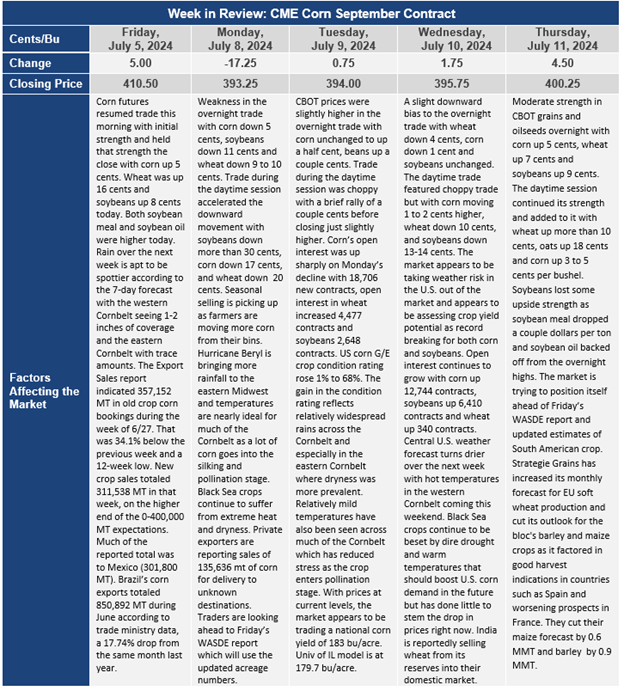Chicago Board of Trade Market News

Outlook
U.S. weather in the primary corn growing regions has seen moderate temperatures and fairly widespread rainfall for the past several weeks and crop conditions going into pollination are relatively good compared to recent years. The eastern Cornbelt has been somewhat dry and as the remnants of Hurricane Beryl moved up the Mississippi Valley and Ohio River Valley it left good amounts of rain in its wake. Many areas in the eastern Cornbelt received 4 to 5 inches of rain in the past week. Hot temperatures are in the forecast for the western Cornbelt in the 10-day forecast but with very good soil moisture conditions, this round of hot temperatures should not create any significant problems as the corn crop enters the pollination stage and soybeans begin the reproductive stages of development.
At current prices, stocks-to-use models are suggesting that the trade is expecting a 183 bushel/acre U.S. national corn yield. A crop-condition model from the University of Illinois reported this week that based on the most recent crop conditions, that model is predicting a national corn yield of 179.7 bushels/acre. It is likely that USDA in their July WASDE report will continue to use the trendline yield that they have used in the past couple of reports of 181 bushels/acre. It is expected that USDA will update the planted and harvested acreage in the WASDE report with the information from the June Planted Acreage Report which will increase both planted acres and harvested acres for corn. It is not likely that USDA will adjust harvested acres for acres that have been flooded in northwest Iowa, southwest Minnesota, or southeast South Dakota until at least the August report and most likely in the October WASDE report. Best-guess estimates of flooded corn acres is between 1.2 to 1.8 million acres nationally.
Analyst pre-report estimates for corn production range from 14.86 billion bushels to 15.11 billion bushels with the average of the analyst estimates being 15.063 billion bushels. The average analyst estimate of soybean production pre-report is 4.42 billion bushels with a range of 4.335 billion bushels to 4.436 billion bushels. Pre-report estimates of 2023-24 ending stocks are 1.997-2.122 billion bushels for corn with an average estimate of 2.049 billion bushels. The soybean estimated ending stocks for 2023-24 range from 0.329-0.390 billion bushels with an average estimate of 0.355 billion bushels. For both corn and soybeans, analysts are expecting the July WASDE report to show a slight increase in 2023-24 ending stocks.
For the 2024-25 marketing year, analysts are expecting corn ending stocks to be between 2.174-2.454 billion bushels with an average of 2.312 billion bushels. This compares to USDA’s June estimate of 2.102 billion bushels. For soybeans in 2024-25, the range on ending stocks is 0.350 – 0.527 billion bushels with an average of the analysts being 0.449 billion bushels. That compares to 0.455 in the USDA June WASDE.
For South American production, analysts expect Argentina corn production of 51.07 MMT with a range from 48 MMT to 53 MMT and compared to USDA May WASDE of 53 MMT. Brazilian corn is estimated to be 121.3 MMT with a range of 120 MMT to 122 MMT and compared to USDA’s May WASDE of 122 MMT.
South American soybean production is expected to be 49.95 MMT in Argentina and 151.75 MMT in Brazil compared to USDA’s 50 MMT in Argentina and 153 MMT in Brazil.
